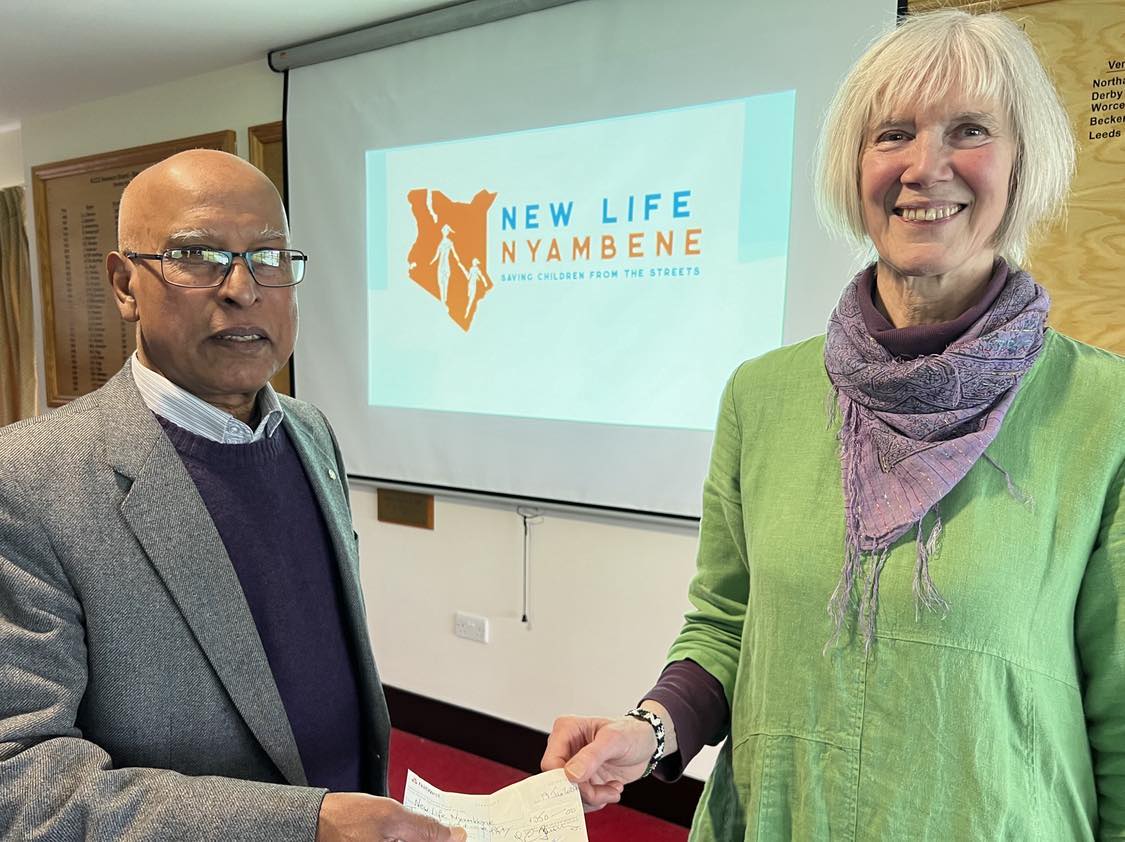
Miriam, founder and chairman of the charity, was introduced to us by Chair of our International Committee, Raj Dasan. She began her presentation by expressing her gratitude in advance for our generosity and for giving her a chance to talk about her work; she also distributed some informative leaflets about the organization.
What does New Life Nyambene do?
Miriam explained that their mission – as depicted in their logo – is to rescue street children, many of whom are orphans, in Maua in Kenya.
Recognizing the high levels of unemployment in the region, the charity doesn’t stop supporting children at the end of their schooling – unlike many other initiatives. It aims to provide ongoing support until the youngsters become self-sufficient, helping them through higher education, apprenticeships, and beyond. The charity’s website features stories of some of the children that they’ve helped. [https://newlifenyambene.org/]
Why do this work?
Miriam shared alarming statistics from the UN estimating that there are around 150 million street children worldwide.
She had found the reality for street children in Kenya deeply disturbing on witnessing it first hand. In Maua alone, there are about 70 street children struggling to eke out a living.
Miriam highlighted the numerous barriers these children face, including lack of an ID, community rejection and the stigma associated with their situation.
The charity has a narrow window of opportunity to rescue the youngsters before they fall into drug/alcohol abuse or early sexual activity.
Successes and failures
Miriam recounted touching stories of some of the children they’ve rescued. She showed us a picture of Tabby who, despite having a father, was forced to spend nights on the streets from a young age due to overcrowded living conditions; her 7 siblings and their father shared one room and the youngsters took turns to stay at night or go to the streets where they were surrounded by prostitution, drug exchange and protectionism.
Another child, Franklin, was discovered sleeping under a banana tree after being stabbed by a member of his own extended family when he’d approached them for help. “When he came to us he was a thin, rickety youngster – now he is doing really well,” Miriam said as she showed us a recent picture of him with other youngsters.
Miriam proudly showcased the progress of these children and showed pictures of her dedicated staff, including project manager Martha and other team members, Pastor Patrick and Purity. She underscored the crucial role that personnel play in the charity’s efforts. (The charity had faced some problems with particular members of staff in its early days.)
Challenges persist for Miriam – “they can be overwhelming sometimes,” she said. As a tall white woman, she can intimidate young children and babies who may have never seen a white person before.
There is also a problem of perception. The locals have a cliched expectation from her and often inundate her with requests for assistance. They naively assume she has far more money than she can use – why else would she be out there? This does unfortunately mean that some people try to cheat her.
The charity also faces superstition and some cultural challenges – such as the fear of curses.
Logistical hurdles can also be hard to deal with. For instance, the charity was operating on a piece of land for 15 years before it became apparent that the land had been subject to earlier fraud. Recently, it has been offered an acre of land by a generous Kenyan friend – but that land becomes impassable in the rainy season which would make it impossible for day scholars to travel to school. Miriam is now looking for ways and funds to deal with this issue.
Despite setbacks, New Life Nyambene remains committed to its mission, exemplified by success stories like Mark, who perseveres in his studies in chemistry despite a truly horrific personal tragedy recently in which close relatives murdered his father: Mark hopes to become a chemistry teacher. Another example is Roy – who has transformed from a troubled 6-year-old orphan who had faced terrible torture and abuse from his grandmother into a caring individual and outstanding academic achiever. Yet another youngster now runs his own electrical shop.
Despite the successes there have been a few failures: Miriam spoke of one youngster who turned to alcohol; nevertheless, they keep in touch. Another youngster proved to be a corrupting influence; the charity therefore sent him back to his village with someone to look after him. The boy now goes to school regularly thanks to the charity paying his fees. He visits them from time to time and when they see him they are keen to show they still care about him.
Last August Miriam had the chance to meet up with some of her older “children”, as she likes to call them. These alumni “couldn’t resist” coming to see her. One, Joy, is now training to be a journalist, with a bright future; another (who had come to them after being found literally in the gutter with the body of her mother) now has a degree in teaching and a child of her own. The greatest success is probably Patrick, who’d been rejected as a small child by his wider family, (symbolised by their urinating on him to demonstrate his non-status in the community). Thanks to the charity, he completed his education and went on to study medicine. He is now a clinical officer and is engaged to be married.
The future?
Miriam spends much of her time fundraising – she needs around £50,000 each year to simply keep the charity going. During her talk she re-emphasized her plans to find land whereby the charity can take children out of the town and teach them how to grow crops and manage land. She also wants to open a clinic with Patrick – perhaps focused on women’s reproductive health.
Miriam’s moving presentation concluded with a bried Q&A and a modest gesture of support from our International Committee, represented by Raj, who presented a cheque for £350 towards Miriam’s work.
Finally President Rosemary expressed gratitude on behalf of our members for Miriam’s enlightening presentation.
If your organization would like Miriam to give you a presentation, please contact her at info@newlifenyambene.org
Picture: Miriam (right) receives a cheque from Chair of our Interntional Committee, Raj Dasan. after her talk. Picture credit: Rotary Club of Canterbury.


